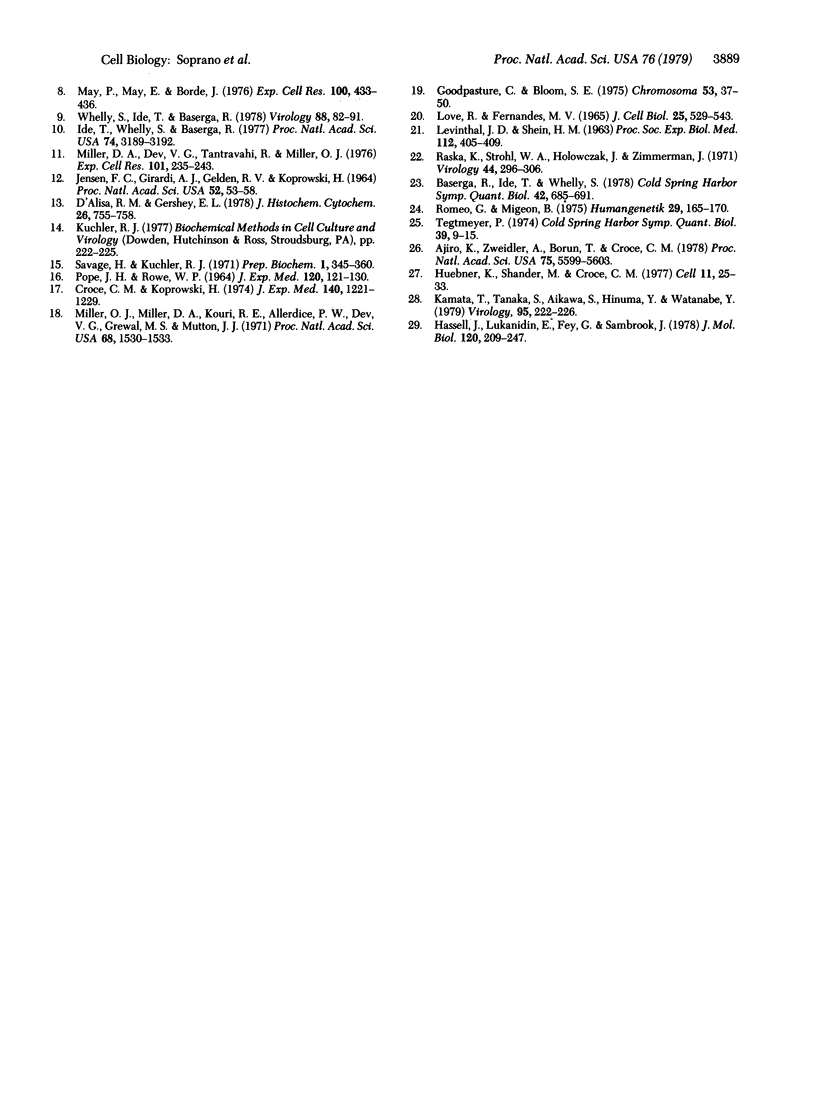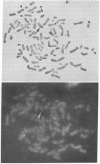Abstract
Mouse-human hybrid cells were used to study the ability of simian virus 40 to regulate the expression of rRNA genes in vivo. In these hybrid cells, only the rRNA genes of the dominant species are expressed; the genes for the rRNA of the recessive species are silent. Simian virus 40 infection of these hybrids led to the production of two distinct 28S rRNA species as analyzed by agarose/2.4% polyacrylamide gel electrophoresis. These species were identified as human and mouse rRNAs. This result was confirmed by histochemical studies which indicated that the nucleolus organizer regions of both mouse and human chromosomes were actively synthesizing rRNA in the virus-infected hybrid cells. These results indicate that simian virus 40 infection can induce the expression of otherwise silent rRNA genes.
Full text
PDF




Images in this article
Selected References
These references are in PubMed. This may not be the complete list of references from this article.
- Ajiro K., Zweidler A., Borun T., Croce C. M. Species-specific suppression of histone H1 and H2B production in human/mouse hybrids. Proc Natl Acad Sci U S A. 1978 Nov;75(11):5599–5603. doi: 10.1073/pnas.75.11.5599. [DOI] [PMC free article] [PubMed] [Google Scholar]
- Croce C. M., Koprowski H. Somatic cell hybrids between mouse peritoneal macrophages and SV40-transformed human cells. I. Positive control of the transformed phenotype by the human chromosome 7 carrying the SV40 genome. J Exp Med. 1974 Nov 1;140(5):1221–1229. doi: 10.1084/jem.140.5.1221. [DOI] [PMC free article] [PubMed] [Google Scholar]
- Croce C. M. Loss of mouse chromosomes in somatic cell hybrids between HT-1080 human fibrosarcoma cells and mouse peritioneal macrophages. Proc Natl Acad Sci U S A. 1976 Sep;73(9):3248–3252. doi: 10.1073/pnas.73.9.3248. [DOI] [PMC free article] [PubMed] [Google Scholar]
- Croce C. M., Talavera A., Basilico C., Miller O. J. Suppression of production of mouse 28S ribosomal RNA in mouse-human hybrids segregating mouse chromosomes. Proc Natl Acad Sci U S A. 1977 Feb;74(2):694–697. doi: 10.1073/pnas.74.2.694. [DOI] [PMC free article] [PubMed] [Google Scholar]
- D'Alisa R. M., Gershey E. L. On the quantitation of SV40 virus by plaque assay and immunoperoxidase technique. J Histochem Cytochem. 1978 Sep;26(9):755–758. doi: 10.1177/26.9.213486. [DOI] [PubMed] [Google Scholar]
- Eliceiri G. L., Green H. Ribosomal RNA synthesis in human-mouse hybrid cells. J Mol Biol. 1969 Apr;41(2):253–260. doi: 10.1016/0022-2836(69)90390-8. [DOI] [PubMed] [Google Scholar]
- Goodpasture C., Bloom S. E. Visualization of nucleolar organizer regions im mammalian chromosomes using silver staining. Chromosoma. 1975 Nov 20;53(1):37–50. doi: 10.1007/BF00329389. [DOI] [PubMed] [Google Scholar]
- Hassell J. A., Lukanidin E., Fey G., Sambrook J. The structure and expression of two defective adenovirus 2/simian virus 40 hybrids. J Mol Biol. 1978 Apr 5;120(2):209–247. doi: 10.1016/0022-2836(78)90065-7. [DOI] [PubMed] [Google Scholar]
- Huebner K., Shander M., Croce C. M. Suppression of replication of SV40 and polyoma virus in mouse-human hybrids. Cell. 1977 May;11(1):25–33. doi: 10.1016/0092-8674(77)90314-2. [DOI] [PubMed] [Google Scholar]
- Ide T., Whelly S., Baserga R. Stimulation of RNA synthesis in isolated nuclei by partially purified preparations of simian virus 40 T-antigen. Proc Natl Acad Sci U S A. 1977 Aug;74(8):3189–3192. doi: 10.1073/pnas.74.8.3189. [DOI] [PMC free article] [PubMed] [Google Scholar]
- JENSEN F. C., GIRARDI A. J., GILDEN R. V., KOPROWSKI H. INFECTION OF HUMAN AND SIMIAN TISSUE CULTURES WITH ROUS SARCOMA VIRUS. Proc Natl Acad Sci U S A. 1964 Jul;52:53–59. doi: 10.1073/pnas.52.1.53. [DOI] [PMC free article] [PubMed] [Google Scholar]
- Kamata T., Tanaka S., Aikawa S., Hinuma Y., Watanabe Y. A possible function of Epstein-Barr virus-determined nuclear antigen (EBNA): stimulation of chromatin template activity in vitro. Virology. 1979 May;95(1):222–226. doi: 10.1016/0042-6822(79)90419-7. [DOI] [PubMed] [Google Scholar]
- LEVINTHAL J. D., SHEIN H. M. Morphology and distribution of SV40-infected cells in human, simian and hamster renal cell cultures as detected by immunofluorescence. Proc Soc Exp Biol Med. 1963 Feb;112:405–409. doi: 10.3181/00379727-112-28059. [DOI] [PubMed] [Google Scholar]
- Love R., Fernandes M. V. Cytological and cytochemical studies of green monkey kidney cells infected in vitro with simian virus 40. J Cell Biol. 1965 Jun;25(3):529–543. doi: 10.1083/jcb.25.3.529. [DOI] [PMC free article] [PubMed] [Google Scholar]
- May P., May E., Bordé J. Stimulation of cellular RNA synthesis in mouse-kidney cell cultures infected with SV40 virus. Exp Cell Res. 1976 Jul;100(2):433–436. doi: 10.1016/0014-4827(76)90175-0. [DOI] [PubMed] [Google Scholar]
- Miller D. A., Dev V. G., Tantravahi R., Miller O. J. Suppression of human nucleolus organizer activity in mouse-human somatic hybrid cells. Exp Cell Res. 1976 Sep;101(2):235–243. doi: 10.1016/0014-4827(76)90373-6. [DOI] [PubMed] [Google Scholar]
- Miller O. J., Miller D. A., Dev V. G., Tantravahi R., Croce C. M. Expression of human and suppression of mouse nucleolus organizer activity in mouse-human somatic cell hybrids. Proc Natl Acad Sci U S A. 1976 Dec;73(12):4531–4535. doi: 10.1073/pnas.73.12.4531. [DOI] [PMC free article] [PubMed] [Google Scholar]
- Miller O. J., Miller D. A., Kouri R. E., Allderdice P. W., Dev V. G., Grewal M. S., Hutton J. J. Identification of the mouse karyotype by quinacrine fluorescence, and tentative assignment of seven linkage groups. Proc Natl Acad Sci U S A. 1971 Jul;68(7):1530–1533. doi: 10.1073/pnas.68.7.1530. [DOI] [PMC free article] [PubMed] [Google Scholar]
- POPE J. H., ROWE W. P. DETECTION OF SPECIFIC ANTIGEN IN SV40-TRANSFORMED CELLS BY IMMUNOFLUORESCENCE. J Exp Med. 1964 Aug 1;120:121–128. doi: 10.1084/jem.120.2.121. [DOI] [PMC free article] [PubMed] [Google Scholar]
- Raska K., Jr, Strohl W. A., Holowczak J. A., Zimmerman J. The response of BHK21 cells to infection with type 12 adenovirus. V. Stimulation of cellular RNA synthesis and evidence for transcription of the viral genome. Virology. 1971 May;44(2):296–306. doi: 10.1016/0042-6822(71)90261-3. [DOI] [PubMed] [Google Scholar]
- Romeo G., Migeon B. R. Stability of X chromosomal inactivation in human somatic cells transformed by SV-40. Humangenetik. 1975 Sep 10;29(2):165–170. doi: 10.1007/BF00430356. [DOI] [PubMed] [Google Scholar]
- Savage H. E., Kuchler R. J. A versatile composite gel column for the electrophoretic separation of ribonucleic acid molecules. Prep Biochem. 1971;1(4):345–360. doi: 10.1080/00327487108081949. [DOI] [PubMed] [Google Scholar]
- Tegtmeyer P. Altered patterns of protein synthesis in infection by SV40 mutants. Cold Spring Harb Symp Quant Biol. 1975;39(Pt 1):9–15. doi: 10.1101/sqb.1974.039.01.004. [DOI] [PubMed] [Google Scholar]
- Weil R., Salomon E., May E., May P. A simplifying concept in tumor virology: virus-specific "pleiotropic effectors". Cold Spring Harb Symp Quant Biol. 1975;39(Pt 1):381–395. doi: 10.1101/sqb.1974.039.01.050. [DOI] [PubMed] [Google Scholar]
- Weiss M. C., Green H. Human-mouse hybrid cell lines containing partial complements of human chromosomes and functioning human genes. Proc Natl Acad Sci U S A. 1967 Sep;58(3):1104–1111. doi: 10.1073/pnas.58.3.1104. [DOI] [PMC free article] [PubMed] [Google Scholar]
- Whelly S., Ide T., Baserga R. Stimulation of RNA synthesis in isolated nucleoli by preparations of simian virus 40 T antigen. Virology. 1978 Jul 1;88(1):82–91. doi: 10.1016/0042-6822(78)90112-5. [DOI] [PubMed] [Google Scholar]



